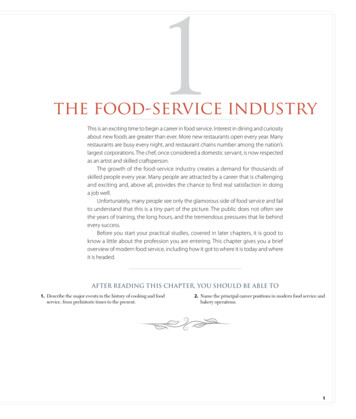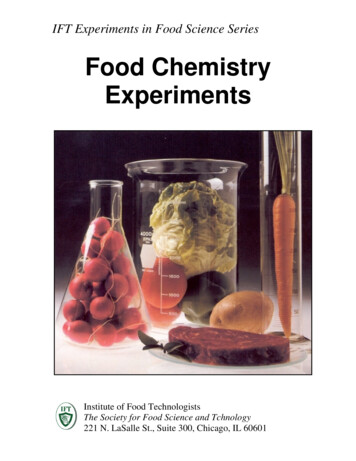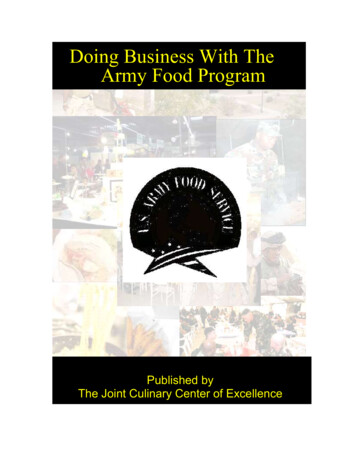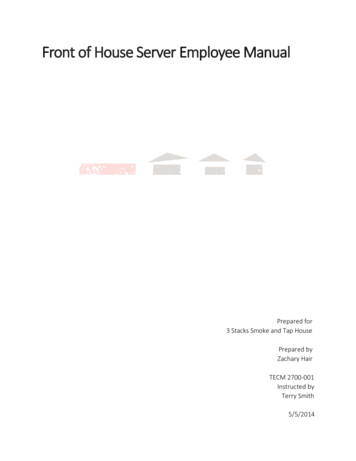
Transcription
1the food-service industryThis is an exciting time to begin a career in food service. Interest in dining and c uriosityabout new foods are greater than ever. More new restaurants open every year. Manyrestaurants are busy every night, and restaurant chains number among the nation’slargest corporations. The chef, once considered a domestic servant, is now respectedas an artist and skilled craftsperson.The growth of the food-service industry creates a demand for thousands ofskilled people every year. Many people are attracted by a career that is challengingand exciting and, above all, provides the chance to find real satisfaction in doinga job well.Unfortunately, many people see only the glamorous side of food service and failto understand that this is a tiny part of the picture. The public does not often seethe years of training, the long hours, and the tremendous pressures that lie behindevery success.Before you start your practical studies, covered in later chapters, it is good toknow a little about the profession you are entering. This chapter gives you a briefoverview of modern food service, including how it got to where it is today and whereit is headed.AFTER READING THIS CHAPTER, YOU SHOULD BE ABLE TO1. Describe the major events in the history of cooking and foodservice, from prehistoric times to the present.2. Name the principal career positions in modern food service andbakery operations.1
2C h a p t e r 1the food-service industryA HISTORY OF MODERN FOOD SERVICEThe value of history is that it helps us understand the present and the future. In food service,knowledge of our professional heritage helps us see why we do things as we do, how our cookingtechniques have been developed and refined, and how we can continue to develop and innovatein the years ahead.An important lesson of history is that the way we cook now is the result of the work done bycountless chefs over hundreds of years. Cooking is as much science as it is art. Cooking techniques arenot based on arbitrary rules some chefs made up long ago. Rather, they are based on an understandingof how different foods react when heated in various ways, when combined in various proportions, andso on. The chefs who have come before us have already done much of this work so we don’t have to.This doesn’t mean there is no room for innovation and experimentation or that we should neverchallenge old ideas. But it does mean a lot of knowledge has been collected over the years, and we wouldbe smart to take advantage of what has already been learned. Furthermore, how can we challengeold ideas unless we know what those old ideas are? Knowledge is the best starting point for innovation.THE ORIGINS OF CLASSICAL AND MODERN CUISINEQuantity cookery has existed for thousands of years, as long as there have been large groups of people to feed, such as armies. But modern food service is said to have begun shortly after the middleof the eighteenth century. At this time, food production in France was controlled by guilds. Caterers,pastry makers, roasters, and pork butchers held licenses to prepare specific items. An innkeeper, inorder to serve a meal to guests, had to buy the various menu items from those operations licensed toprovide them. Guests had little or no choice and simply ate what was available for that meal.In 1765, a Parisian named Boulanger began advertising on his shop sign that he served soups,which he called restaurants or restoratives. (Literally, the word means “fortifying.”) According to oneversion of the story, one of the dishes he served was sheep’s feet in a cream sauce. The guild ofstew makers challenged him in court, but Boulanger won by claiming he didn’t stew the feet in thesauce but served them with the sauce. In challenging the rules of the guilds, Boulanger unwittinglychanged the course of food-service history.The new developments in food service received a great stimulus as a result of theFrench Revolution, beginning in 1789. Before this time, the great chefs were employed in thehouses of the French nobility. With the revolution and the end of the monarchy, many chefs, suddenly out of work, opened restaurants in and around Paris to support themselves. Furthermore, the revolutionary government abolished the guilds. Restaurants and inns could servedinners reflecting the talent and creativity of their own chefs rather than being forced to relyon licensed caterers to supply their food. At the start of the French Revolution, there were about50 restaurants in Paris. Ten years later, there were about 500.Another important invention that changed the organization of kitchens in the eighteenthcentury was the stove, or potager, which gave cooks a more practical and controllable heat sourcethan an open fire. Soon commercial kitchens became divided into three departments: the rotisserie,under the control of the meat chef, or rôtisseur; the oven, under the control of the pastry chef, orpâtissier; and the stove, run by the cook, or cuisinier. The meat chef and pastry chef reported to thecuisinier, who was also known as chef de cuisine, which means “head of the kitchen.”CARÊMEMarie-Antoine Carême. L’Art de la Cuisine Françaiseau Dix-Neuvième Siècle. Paris: L’auteur, 1833–1844.Courtesy of the Rare Manuscript Collections,Cornell University Library.All the changes that took place in the world of cooking during the 1700s led to, for the first time,a difference between home cooking and professional cooking. One way we can try to understandthis difference is to look at the work of the greatest chef of the period following the French Revolution, Marie-Antoine Carême (1784–1833). As a young man, Carême learned all the branches of cook ing quickly, and he dedicated his career to refining and organizing culinary techniques. His manybooks contain the first systematic account of cooking principles, recipes, and menu making.At a time when the interesting advances in cooking were happening in restaurants, Carêmeworked as a chef to wealthy patrons, kings, and heads of state. He was perhaps the first real celebrity chef, and he became famous as the creator of elaborate, elegant display pieces and pastries, theancestors of our modern wedding cakes, sugar sculptures, and ice and tallow carvings. But it wasCarême’s practical and theoretical work as an author and an inventor of recipes that was responsible,to a large extent, for bringing cooking out of the Middle Ages and into the modern period.
A HISTORY OF M O D ERN FOO D SERVICECarême emphasized procedure and order. His goal was to create more lightness and simplicity.The complex cuisine of the aristocracy—called Grande Cuisine—was still not much different fromthat of the Middle Ages and was anything but simple and light. Carême’s efforts were a great steptoward modern simplicity. The methods explained in his books were complex, but his aim was pureresults. He added seasonings and other ingredients not so much to add new flavors but to highlightthe flavors of the main ingredients. His sauces were designed to enhance, not cover up, the foodbeing sauced. Carême was a thoughtful chef, and, whenever he changed a classic recipe, he wascareful to explain his reasons for doing so.Beginning with Carême, a style of cooking developed that can truly be called international,because the same principles are still used by professional cooks around the world. Older styles ofcooking, as well as much of today’s home cooking, are based on tradition. In other words, a cookmakes a dish a certain way because that is how it always has been done. In Carême’s Grande Cuisine,and in professional cooking ever since, a cook makes a dish a certain way because the principles andmethods of cooking show it is the best way to get the desired results. For example, for hundreds ofyears, cooks boiled meats before roasting them on a rotisserie in front of the fire. But when chefsbegan thinking and experimenting rather than just accepting the tradition of boiling meat beforeroasting, they realized either braising the meat or roasting it from the raw state were better options.ESCOFFIERGeorges-Auguste Escoffier (1847–1935), the greatest chef of his time, is still revered by chefsand gourmets as the father of twentieth-century cookery. His two main contributions were (1) thesimplification of classical cuisine and the classical menu, and (2) the reorganization of the kitchen.Escoffier rejected what he called the “general confusion” of the old menus, in which sheerquantity seemed to be the most important factor. Instead, he called for order and diversity andemphasized the careful selection of one or two dishes per course, dishes that followed one anotherharmoniously and delighted the taste with their delicacy and simplicity.Escoffier’s books and recipes are still important reference works for professional chefs. The basiccooking methods and preparations we study today are based on Escoffier’s work. His book Le GuideCulinaire, which is still widely used, arranges recipes in a simple system based on main ingredientand cooking method, greatly simplifying the more complex system handed down from Carême.Learning classical cooking, according to Escoffier, begins with learning a relatively few basic procedures and understanding basic ingredients.Escoffier’s second major achievement, the reorganization of the kitchen, resulted in a streamlined workplace better suited to turning out the simplified dishes and menus he instituted. Thesystem of organization he established is still in use, especially in large hotels and full-service restaurants, as we discuss later in this chapter.Georges-Auguste Escoffier.Courtesy of Adjointe à la Conservation du MuséeEscoffier de l’Art Culinaire.CATERINA DE MEDICIThe Medicis were a powerful Italian family that ruled Florence fromthe fourteenth to the sixteenth century and provided, in addition to therulers of Florence, three popes and two queens of France.Until recently, the accepted and often-told story is that whenCaterina de Medici went to France in 1533 to marry the futureKing Henry II, she brought with her a staff of cooks as part of herhousehold. This introduction of Italian cooking practices into Francesupposedly changed and modernized the cooking not only of Francebut of all of Western Europe. According to this story, Caterina and herItalian cooks should be credited with fostering modern cuisine.When cookbooks and other culinary writings of the period areexamined, however, it appears that French cooking didn’t begin tomodernize until at least a century later. During the hundred yearsafter Caterina’s arrival in France, no new, important cookbooks werewritten. There is no sign of a revolution in cooking. In fact, banquetmenus that survive from the period are not much different frommenus of the Middle Ages.Banquets during the Middle Ages were like huge, sit-down buffets. For each course, the table was loaded with large quantitiesof meats, poultry, and fish dishes, usually heavily spiced, and anassortment of side dishes and sweets. Diners generally ate only whatthey could reach. The course was then removed and another course,also meats and side dishes, was loaded onto the table. Again, eachperson ate only a fraction of the dishes present, depending on whatwas within reach.The modern idea of a menu in which everyone at the table eatsthe same dishes in the same order did not appear until the 1700s.So on the one hand, it is not historically accurate to give the Italianprincess Caterina credit for modernizing French cuisine. On theother hand, it is fair to say she and her offspring brought more refinedmanners and elegance to European dining rooms. Italian innovationsincluded the use of the fork as well as greater cleanliness in general.An additional Italian contribution was the invention of sophisticatedpastries and desserts.3
4C h a p t e r 1the food-service industryTWO IMPORTANTCOOKBOOKSIn the Middle Ages, cooking consistedmostly of roasting meats on spits in frontof a fire and suspending pots from hooksover the fire. Ovens, which were used inancient Rome, had disappeared, so therewas no baking. Roasted meats and poultrywere usually boiled before being placedon the spit, and most foods were heavilyspiced. It wasn’t until the thirteenthcentury that ovens were used again andthat stews and sauces started to appear onthe dining table.Perhaps the first important cookbookto appear at the end of the Middle Ageswas Le Viandier (“The Cook”), by Guillaume Tirel, usually known as Taillevent, born about 1310.Taillevent invented many dishes, especially sauces and soups. He refined oldrecipes to depend less on heavy use ofspices and more on the flavors of the foodsthemselves. He wrote his book before theinvention of the printing press, and handwritten copies of it remained in use formore than a century, until 1490, when itbecame perhaps the first cookbook everprinted.By the seventeenth century, cookingpractices still had not advanced muchbeyond Taillevent’s day. Perhaps the nextmost important cookbook after T aillevent’swas Le Cuisinier François (“The FrenchChef ”), by François-Pierre de La Varenne(1615–1678). This book, published in1651, was a summary of the cooking practices in households of the aristocracy. Itwas one of the first books to present recipes and cooking techniques in an orderlyfashion rather than as an unsystematiccollection. Le Cuisinier François was oneof the main reference works for cooks formore than 150 years.These two chefs are memorialized inthe names of two important culinary institutions. Taillevent is the name of a Parisrestaurant that has long been one of thefinest in France, and La Varenne is thename of a distinguished cooking school.MODERN TECHNOLOGYToday’s kitchens look much different from those of Escoffier’s day, even though our basic cookingprinciples are the same. Also, the dishes we eat have gradually changed due to the innovationsand creativity of modern chefs. The process of simplification and refinement, to which Carême andEscoffier made monumental contributions, is ongoing, adapting classical cooking to modern conditions and tastes.Before we discuss the changes in cooking styles that took place in the twentieth century, let’slook at some of the developments in technology that affected cooking.Development of New EquipmentWe take for granted such basic equipment as gas and electric ranges and ovens and electric refrigerators. But even these essential tools did not exist until fairly recently. The easily controlled heat ofmodern cooking equipment, as well as motorized food cutters, mixers, and other processing equipment, has greatly simplified food production.Research and technology continue to produce sophisticated tools for the kitchen. Some ofthese products, such as tilting skillets and steam-jacketed kettles, can do many jobs and are popularin many kitchens. Others can perform specialized tasks rapidly and efficiently, but their usefulnessdepends on volume because they are designed to do only a few jobs.Modern equipment has enabled many food-service operations to change their productionmethods. With sophisticated cooling, freezing, and heating equipment, it is possible to preparesome foods further in advance and in larger quantities. Some large multiunit operations preparefood for all their units in a central commissary. The food is prepared in quantity, packaged, chilled orfrozen, and then heated or cooked to order in the individual units.Development and Availability of New Food ProductsModern refrigeration and rapid transportation caused revolutionary changes in eating habits.For the first time, fresh foods of all kinds—meats, fish, vegetables, and fruits—became availablethroughout the year. Exotic delicacies can now be shipped from anywhere in the world and arrivefresh and in peak condition.The development of preservation techniques—not just refrigeration but also freezing, canning,freeze-drying, vacuum-packing, and irradiation—increased the availability of most foods and madeaffordable some that were once rare and expensive.Techniques of food preservation have had another effect. It is now possible to do some or mostof the preparation and processing of foods before shipping rather than in the food-service operationitself. Thus, convenience foods have come into being. Convenience foods continue to account for anincreasing share of the total food market.Some developments in food science and agriculture are controversial. Irradiation, mentionedabove, caused much controversy when it was introduced because it exposes foods to radioactivityto rid them of organisms that cause spoilage and disease. Scientists say, however, that no traces ofradioactivity remain in the foods, and the procedure is now used more widely.A more controversial technique is genetic engineering, which involves artificially changing thegene structure of a food to give it some desirable trait, such as resistance to disease, drought, orinsect damage.Food Safety and Nutritional AwarenessThe development of the sciences of microbiology and nutrition had a great impact on food service.One hundred years ago, there was little understanding of the causes of food poisoning and foodspoilage. Food-handling practices have come a long way since Escoffier’s day.Also, little knowledge of nutritional principles was available until fairly recently. Today, nutrition is an important part of a cook’s training. Customers are also more knowledgeable and thereforemore likely to demand healthful, well-balanced menus. Unfortunately, nutrition science is constantlyshifting. Diets considered healthful one year become eating patterns to be avoided a few years later.Fad diets come and go, and chefs often struggle to keep their menus current. It is more importantthan ever for cooks to keep up to date with the latest nutritional understanding.Complicating the work of food-service professionals is a growing awareness of food allergiesand intolerances. Not only are chefs called upon to provide nutritious, low-fat, low-calorie meals,they must also adapt to the needs of customers who must eliminate certain foods from their diets,such as gluten, soy, dairy, or eggs.
A HISTORY OF M O D ERN FOO D SERVICECOOKING IN THE TWENTIETH AND TWENTY-FIRST CENTURIESAll these developments have helped change cooking styles, menus, and eating habits. The evolutionof cuisine that has been going on for hundreds of years continues. Changes occur not only becauseof technological developments, such as those just described, but also because of our reactions toculinary traditions.Two opposing forces can be seen at work throughout the history of cooking. One is the urgeto simplify, to eliminate complexity and ornamentation, and instead to emphasize the plain, naturaltastes of basic, fresh ingredients. The other is the urge to invent, to highlight the creativity of thechef, with an accent on fancier, more complicated presentations and procedures. Both these forcesare valid and healthy; they continually refresh and renew the art of cooking.A generation after Escoffier, the most influential chef in the middle of the twentieth century wasFernand Point (1897–1955). Working quietly and steadily in his restaurant, La Pyramide, in Vienne,France, Point simplified and lightened classical cuisine. He was a perfectionist who sometimesworked on a dish for years before he felt it was good enough to put on his menu. “I am not hard toplease,” he said. “I’m satisfied with the very best.” Point insisted every meal should be “a little marvel.”Point’s influence extended well beyond his own life. Many of his apprentices, including PaulBocuse, Jean and Pierre Troisgros, and Alain Chapel, later became some of the greatest stars ofmodern cooking. They, along with other chefs in their generation, became best known in the 1960sand early 1970s for a style of cooking called nouvelle cuisine. Reacting to what they saw as aheavy, stodgy, overly complicated classical cuisine, these chefs took Point’s lighter approach evenfurther. They rejected many traditional principles, such as the use of flour to thicken sauces, andinstead urged simpler, more natural flavors and preparations, with lighter sauces and seasoningsand shorter cooking times. In traditional classical cuisine, many dishes were plated in the diningroom by waiters. Nouvelle cuisine, however, placed a great deal of emphasis on artful plating presentations done by the chef in the kitchen.Very quickly, however, this “simpler” style became extravagant and complicated, famous forstrange combinations of foods and fussy, ornate arrangements and designs. By the 1980s, nouvellecuisine was the subject of jokes. Still, the best achievements of nouvelle cuisine have taken apermanent place in the classical tradition. Meanwhile, many of its excesses have been forgotten. Itis probably fair to say that most of the best new ideas and the longest-lasting accomplishments arethose of c lassically trained chefs with a solid grounding in the basics.New Emphasis on IngredientsAdvances in agriculture and food preservation have had disadvantages as well as advantages. Everyone is familiar with hard, tasteless fruits and vegetables developed to shipwell and last long, without regard for eating quality. Many people, including chefs, beganto question not only the flavor but also the health value and the environmental effects ofgenetically engineered foods, of produce raised with chemical pesticides and fertilizers,and of animals raised with antibiotics and other drugs and hormones.A prominent organization dedicated to improving food quality is Slow Food,begun in Italy in 1986 in reaction to the spread of fast-food restaurants. Slow Food hassince become a global movement, with chapters in cities around the world. It emphasizes fostering locally grown food, using organic and sustainable farming practices, preserving heirloom varieties of plants and animals, and educating consumers about thefood they eat.A landmark event in the history of modern North American cooking was the opening of Alice Waters’s restaurant, Chez Panisse, in Berkeley, California, in 1971. Waters’sphilosophy is that good food depends on good ingredients, so she set about findingdependable sources of the best-quality vegetables, fruits, and meats, and preparingthem in the simplest ways. Over the next decades, many chefs and restaurateurs followed her lead, seeking out the best seasonal, locally grown, organically raised foodproducts. A few years after Chez Panisse opened, Larry Forgione picked up the banner of local ingredients and local cuisine in his New York City restaurant, An AmericanPlace. Other chefs quickly followed suit, and soon chefs across the continent madenames for themselves and their restaurants at least in part by emphasizing good-qualitylocal ingredients. Half a century ago, nearly all the most respected chefs workingin the United States and Canada were European-born. Today, the movement begunby the pioneering, quality-oriented chefs of the 1970s and 1980s has fostered a greatSLOW FOOD TODAYAs with any movement, the growth of Slow Food hasnot been without controversy. For more than 20 yearsafter its founding, Slow Food had little impact inNorth America, finding greater popularity in Europe.As recently as 2008, the organization had only 16,000members in the United States out of more than100,000 in all.In its earlier years, the movement was sometimescriticized for elitism and snobbishness, for focusingprimarily on pleasure, and for being against technology and globalization. Detractors said oppositionto global food trade and rejection of industrial agricultural practices are unrealistic in today’s world.In recent years, however, Slow Food has expandedits focus and has addressed issues of race, poverty, andhunger as well as its more traditional concerns—thedisappearance of local food traditions and people’sdwindling interest in the food they eat, where it comesfrom, and how it tastes. A surge of interest in SlowFood has come at the same time as growing concernsabout the environment and climate change. Membersencourage sustainable, ecologically sound agricultureand stewardship of the land as part of their effortsto educate people about their food and their eatinghabits.5
6C h a p t e r 1the food-service industrynumber of creative North American–born chefs who are among the most respected inthe world.Concern for quality of ingredients has led many chefs to support and to purchaseGenetically modified organisms, or GMOs, are plantsfromfarmers who practice sustainable agriculture. This term refers to methods ofor animals that have had their genes artificially alteredraisinghealthful food in a way that is profitable to farms and farming communities andto make them more productive in one or more ways,that provides living wages and benefits to workers while at the same time preserving andsuch as giving them increased resistance to disease orenhancing the soil, water, and air. Sustainable farming treats workers justly and raisesto herbicides. Those who support the use of GMOsargue that this is an important way to increase cropanimals in humane conditions. Farmers continually work to increase the fertility andyields to feed an ever-growing population while usingconservation of soil and avoid the use of synthetic pesticides and herbicides as much asless land and that there is so far no good scientific evipossible. The goal is to manage farmlands so that they will not only be profitable but alsodence of their harmfulness. But opponents, includingcontinue to be productive indefinitely.many chefs, feel that there are too many unknownsChefs can carry the concept of sustainability into their own operations by usingand possible long-term risks, whether to the healthrenewable power sources, installing energy-efficient equipment, and recycling as manyand sustainability of food crops or to the health ofwaste materials as possible.those who eat these plant and animal foods.When products are raised without the use of drugs and artificial chemicals, theseMany chefs in the farm-to-table movement areproductsmay be legally qualified to be labeled organic (or, in French, biologique). Seeopposed to the use of GMOs. They feel that using pripage 282 for a more detailed explanation of the “organic” label and what its requirementsmarily locally sourced ingredients helps them knoware. Going even beyond organic farming is a practice called biodynamic agriculture (seemore about the foods they buy and thus avoid purchasing GMOs.sidebar). This practice is not widespread, but some chefs see it as an important component of sustainability.Sustainable agriculture often champions the use of heirloom varieties of fruits andvegetables, which are older varieties of plants that existed decades ago, before modernindustrial agriculture began developing hybrid fruits and vegetables that were bred tobe more productive and to better withstand mechanized harvesting and shipping longdistances. Many people feel that modern hybridization has bred the flavor out of foods,and growing heirloom varieties results in products with better flavor and texture.Biodynamic AgricultureClosely related to the concept of sustainability is the farm-to-table movement,Like organic agriculture, biodynamic agriculturealso referred to as farm-to-fork. Restaurants that promote farm-to-table support usingemphasizes the importance of natural soil nutrients,locally produced foods, whether from nearby farms, fisheries, ranches, or other foodsuch as compost and manure, and avoids the use ofproducers. They also highlight locally made wines, beers, and other products on theirpesticides, herbicides, and other artificial chemimenus. Names of local farmers and ranchers are often included on menus, so that cuscals. However, it goes beyond organic farming intomers are fully aware of the sources of their food.its practice of treating soil, animals, and crops as aUsing locally produced foods is certainly not new. For many decades, chefs could besingle system and its efforts to engage cosmic forcesfound early in the morning scouring local farmers markets to find the freshest produce, orand spiritual concepts in planting and harvestingvisiting a local chicken producer to place an order in person. In recent years, the growth of practices.the movement has been due, at least in part, to concerns about the freshness and safetyInternational standards exist for biodynamicof ingredients. Certainly local ingredients can arrive in the restaurant kitchen in a muchfarming, and a number of certification agencies willfresher state than foods shipped long distances. In addition, the chef or restaurant ownerverify whether specific products meet these standards.Although it originated in the 1920s, biodynamiccan be more fully informed about local farming practices and methods, information thatagriculture is in limited use; it is practiced on onlymay not be available from large food producers at a distance. Concerns about agriculturalabout 400,000 acres worldwide, nearly half of thatpractices, such as the use of GMOs (see sidebar), have spurred many chefs to learn moretotal in Germany.about how the foods they use have been grown. Knowing where food comes from, andpassing this information to customers, is seen as important.The public has benefited greatly from these efforts. Today, in supermarkets as wellas in restaurants, a much greater variety of high-quality foods is available than there was40 or 50 years ago. Many chefs have modified their cooking styles to highlight the natural flavorsand textures of their ingredients, and their menus are often simpler now for this reason.GMOsInternational InfluencesAfter the middle of the twentieth century, as travel became easier and as new waves of immigrantsarrived in Europe and North America from around the world, awareness of and taste for regionaldishes grew. Chefs became more knowledgeable not only about the traditional cuisines of otherparts of Europe but also about those
The Medicis were a powerful Italian family that ruled Florence from the fourteenth to the sixteenth century and provided, in addition to the rulers of Florence, three popes and two queens of France. Until recently, the accepted and often-told story is that when Caterina de Medici went to France in 1533 to marry the future










